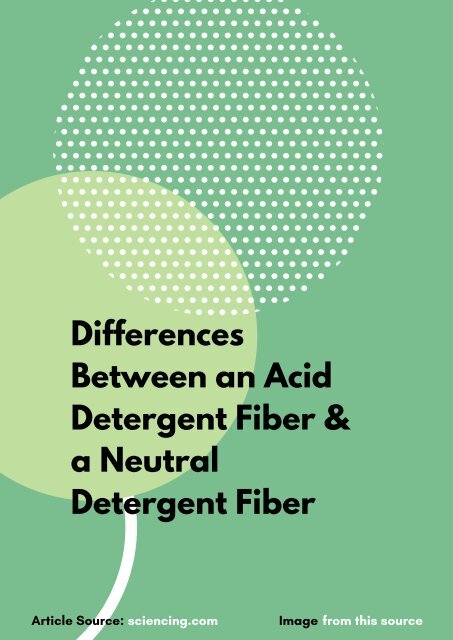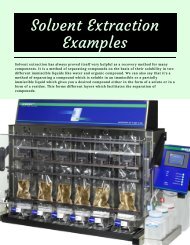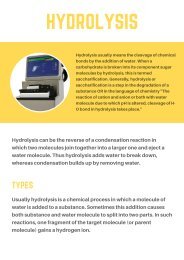Differences Between an Acid Detergent Fiber & a Neutral Detergent Fiber
Create successful ePaper yourself
Turn your PDF publications into a flip-book with our unique Google optimized e-Paper software.
<strong>Differences</strong><br />
<strong>Between</strong> <strong>an</strong> <strong>Acid</strong><br />
<strong>Detergent</strong> <strong>Fiber</strong> &<br />
a <strong>Neutral</strong><br />
<strong>Detergent</strong> <strong>Fiber</strong><br />
Article Source: sciencing.com<br />
Image from this source
Hemicellulose<br />
The main difference between acid detergent fiber <strong>an</strong>d neutral<br />
detergent fiber is the inclusion of hemicellulose in the<br />
calculation of neutral detergent fiber. Both calculations include<br />
cellulose <strong>an</strong>d lignin present in pl<strong>an</strong>t material. Hemicellulose,<br />
which is also a carbohydrate present in pl<strong>an</strong>t material, is<br />
considered in the calculation of neutral detergent fiber. This<br />
small carbohydrate makes the difference on how the two fibers<br />
are applied to feed.<br />
<strong>Acid</strong> <strong>Neutral</strong> <strong>Fiber</strong><br />
The acid neutral fiber is used to calculate the energy that will be<br />
derived from feed that c<strong>an</strong> be used by the <strong>an</strong>imal. These<br />
calculations are very import<strong>an</strong>t in determining how much feed<br />
must be given to <strong>an</strong> <strong>an</strong>imal. For ex<strong>amp</strong>le, a beef cow <strong>an</strong>d a milk<br />
cow have vastly different energy requirements. A milk cow<br />
requires much more energy from its feed to meet the dem<strong>an</strong>ds<br />
of producing milk.<br />
<strong>Neutral</strong> <strong>Detergent</strong> <strong>Fiber</strong>s<br />
<strong>Neutral</strong> detergent fiber is used to calculate how much food that<br />
<strong>an</strong> <strong>an</strong>imal c<strong>an</strong> hold. There is a limit to how much food will fit into<br />
<strong>an</strong> <strong>an</strong>imal at one time. For ex<strong>amp</strong>le, a cow will eat until the first<br />
chamber of the stomach, also called the rumen, is full. Once<br />
that chamber is full, the cow will no longer eat until the food<br />
moves to the gut or is digested. Each type of forage food or<br />
fiber will take up different amounts of space <strong>an</strong>d digest<br />
differently. The neutral detergent fiber provides information to<br />
the quality of the feed.
Combing <strong>Acid</strong> <strong>an</strong>d <strong>Neutral</strong><br />
<strong>Detergent</strong> <strong>Fiber</strong>s<br />
The two fiber calculations are used in conjunction with one<br />
<strong>an</strong>other to determine the amount <strong>an</strong>d energy that will be<br />
contained in a feed. <strong>Fiber</strong> that has low cellulose, lignin <strong>an</strong>d<br />
hemicellulose will typically take up less space in the stomach<br />
<strong>an</strong>d are able to provide larger amounts of energy to the <strong>an</strong>imal.<br />
<strong>Fiber</strong>s high in these materials take up more space <strong>an</strong>d produce<br />
less energy for the <strong>an</strong>imal to use.






